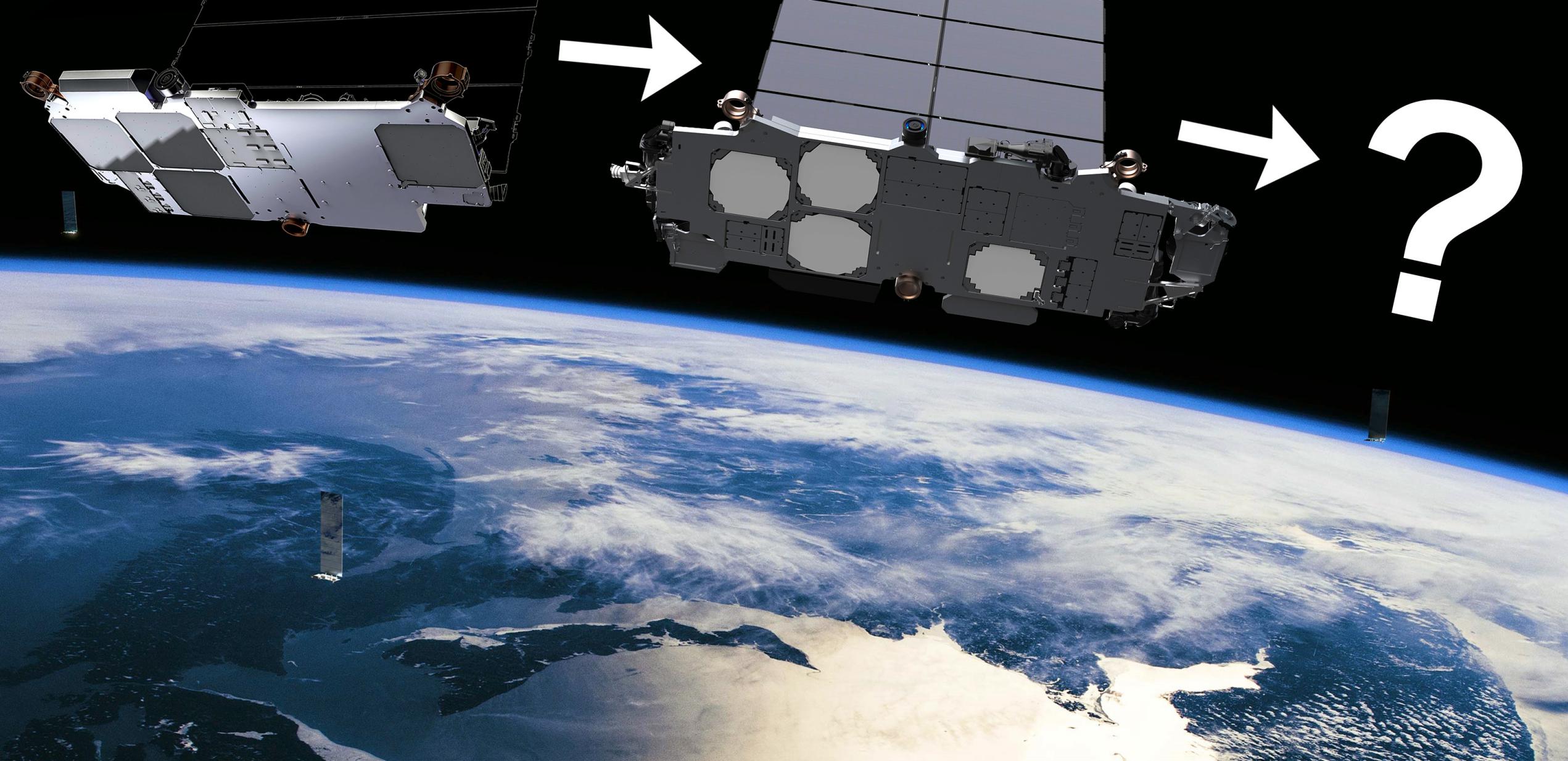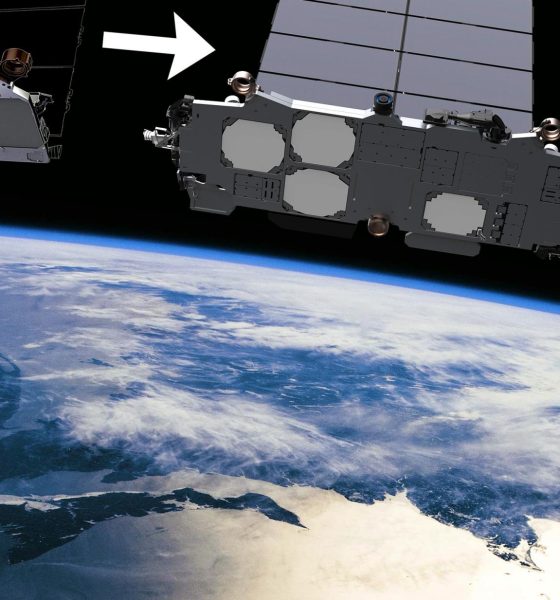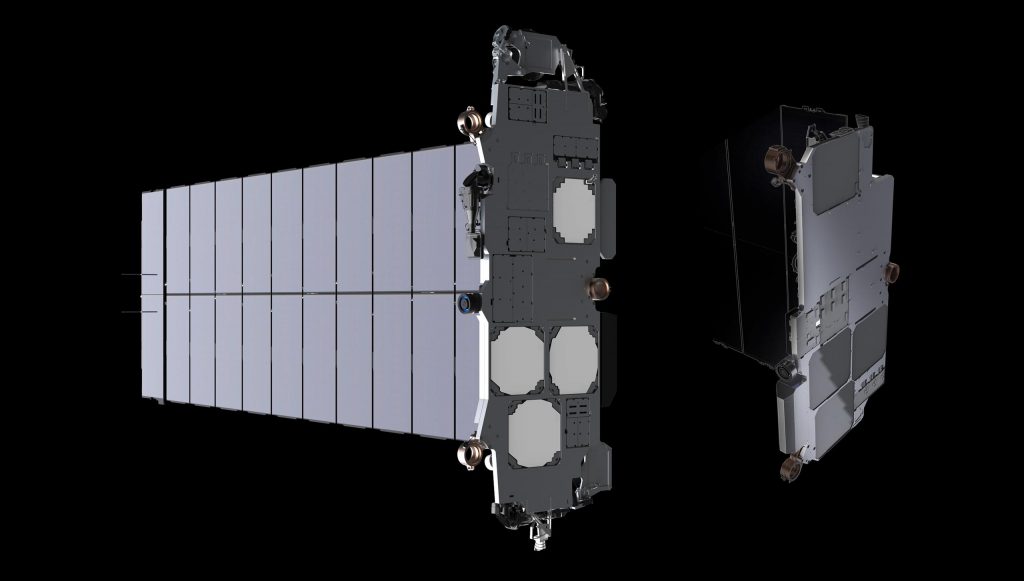

News
SpaceX CEO Elon Musk reveals next-generation Starlink satellite details
SpaceX CEO Elon Musk has revealed the first technical details about the company’s next-generation Starlink ‘Gen2’ satellite design, confirming that it will far outmatch the current generation of satellites by almost every measure.
Speaking in an onsite interview and Starbase tour with YouTuber Tim Dodd (The Everyday Astronaut), Musk – largely unprovoked – revealed that SpaceX has already built at least one functional Starlink Gen2/V2.0 satellite prototype and shipped it to the South Texas Starship factory, where it is currently being stored. More importantly, Musk also provided the first direct specifications for the next-generation spacecraft, stating that each Starlink V2.0 satellite will weigh about 1.25 tons (~2750 lb), measure about seven meters (~23 ft) long, and be almost an order of magnitude more capable than the “Starlink 1” satellites they’ll ultimately supersede.
Almost ten months after SpaceX first revealed its updated plans for a next-generation, 30,000-satellite constellation, those details have confirmed a few key points of speculation about the future of Starlink.
The 1st #SpaceX #Starlink Gen 2 #satellite has been produced. It’s 7 meters long & 1.2 tons, @elonmusk says. Note: that’s 4-5X more massive than Gen 1!
Musk adds, the new version will be almost an order of magnitude more capable than Starlink 1 in terms of useful data throughput.— Stan Shull (@stanshull) May 26, 2022
Back in August 2021, I surmised that just like it has with Falcon 9, SpaceX would again try to optimize its new Starlink V2.0 satellite design to take maximum advantage of Starship’s launch performance. In an updated Starlink Gen2 filing, the company conveniently revealed that a version of the constellation optimized for Starship would be structured such that the rocket could launch an entire orbital plane (one ring of satellites spaced evenly around the Earth) in one go. In that constellation variant, all but ~500 (1.5%) of almost 30,000 spacecraft would be stationed in planes of 110 or 120 satellites, meaning that it was safe to assume that SpaceX meant that every Starship would nominally carry 110-120 satellites. Using Musk’s latest optimistic Starship performance estimate of 150 tons to low Earth orbit (LEO), that all but guaranteed that a Starship-optimized Starlink V2.0 satellite would weigh up to 1250 kilograms.
Musk has now explicitly confirmed that each Starlink V2.0 satellite will weigh… “about one and a quarter tons” or 1250 kilograms. Starlink V1.0 and V1.5 satellites weigh around 260 and 310 kilograms, respectively, meaning that Starlink V2.0 satellites will be about a bit more than four times heavier than V1.5 and a bit less than five times heavier than V1.0.
Musk also revealed that V2.0 satellites will be “almost an order of magnitude more capable than Starlink 1.” He refused to call that capability bandwidth or throughput, the traditional method of describing a communication satellite’s total performance, but Starlink V1.0 satellites are believed to have a total bandwidth of 18 gigabits per second (18 Gbps). As of today, it’s unknown if Starlink V1.5 – a significant upgrade – also added more bandwidth, nor if Musk was referring to that latest Starlink V1.x iteration. But even if he was comparing V2.0 with the earliest V1.0 satellites, it’s possible that each Starlink V2.0 satellite could add around 140-160 Gbps to the 30,000-satellite constellation.

Ultimately, specific numbers aren’t needed to emphasize the importance of the details Musk provided. If true, they mean that Starlink V2.0 will pack roughly twice as much usable bandwidth into a given unit of satellite mass compared to V1.x. Combined with the fact that Starship could offer ~10 times as much performance to LEO as Falcon 9, a single Starship launch could theoretically expand total network capacity roughly twenty times more than one Falcon 9 launch. For example, each Falcon 9 launch of 60 260-kilogram Starlink V1.0 satellites added about 1080 Gbps of instantaneous bandwidth to the constellation. A Starship launch of 120 1250-kilogram Starlink V2.0 satellites could add around 19,000 Gbps (19 terabits per second).
Even despite those massive advantages, SpaceX’s Starlink Gen2 ambitions still leave it no slack whatsoever. If the FCC approves its license request, SpaceX would need to launch half of the constellation within six years – equivalent to around 130 Starship launches or 22 Starship launches per year. In comparison, Falcon 9 – a rocket that’s ten times smaller, less reusable, and has been flying since 2010 – did not achieve 22 launches in one year until 2020. For Starship to have any hope of achieving the cadence Starlink Gen2 requires, SpaceX would have to ramp up launches of the largest rocket ever built at a truly miraculous pace and suffer very few failures or setbacks along the way.
As immense as the challenge may be, the potential rewards are just as high. A constellation of 30,000 Starlink V2.0 satellites – if spaced evenly around the Earth – could have a total bandwidth of ~1250 terabits per second (Tbps) available over land (excluding Antarctica) at any given second. Even if half of that bandwidth is needed for backhaul and routing, the total installed bandwidth of global internet infrastructure was estimated to be 600 Tbps in 2020. Starlink will always be bottlenecked by the number of satellites that can be simultaneously available over any single point on Earth, so the constellation will never be able to match a ground network 1:1 with the same installed capacity, but it’s safe to assume that Starlink Gen2 could serve tens or even hundreds of millions of users located anywhere on Earth if SpaceX is able to build it.

Elon Musk
Starlink passes 9 million active customers just weeks after hitting 8 million
The milestone highlights the accelerating growth of Starlink, which has now been adding over 20,000 new users per day.

SpaceX’s Starlink satellite internet service has continued its rapid global expansion, surpassing 9 million active customers just weeks after crossing the 8 million mark.
The milestone highlights the accelerating growth of Starlink, which has now been adding over 20,000 new users per day.
9 million customers
In a post on X, SpaceX stated that Starlink now serves over 9 million active users across 155 countries, territories, and markets. The company reached 8 million customers in early November, meaning it added roughly 1 million subscribers in under seven weeks, or about 21,275 new users on average per day.
“Starlink is connecting more than 9M active customers with high-speed internet across 155 countries, territories, and many other markets,” Starlink wrote in a post on its official X account. SpaceX President Gwynne Shotwell also celebrated the milestone on X. “A huge thank you to all of our customers and congrats to the Starlink team for such an incredible product,” she wrote.
That growth rate reflects both rising demand for broadband in underserved regions and Starlink’s expanding satellite constellation, which now includes more than 9,000 low-Earth-orbit satellites designed to deliver high-speed, low-latency internet worldwide.
Starlink’s momentum
Starlink’s momentum has been building up. SpaceX reported 4.6 million Starlink customers in December 2024, followed by 7 million by August 2025, and 8 million customers in November. Independent data also suggests Starlink usage is rising sharply, with Cloudflare reporting that global web traffic from Starlink users more than doubled in 2025, as noted in an Insider report.
Starlink’s momentum is increasingly tied to SpaceX’s broader financial outlook. Elon Musk has said the satellite network is “by far” the company’s largest revenue driver, and reports suggest SpaceX may be positioning itself for an initial public offering as soon as next year, with valuations estimated as high as $1.5 trillion. Musk has also suggested in the past that Starlink could have its own IPO in the future.
News
NVIDIA Director of Robotics: Tesla FSD v14 is the first AI to pass the “Physical Turing Test”
After testing FSD v14, Fan stated that his experience with FSD felt magical at first, but it soon started to feel like a routine.

NVIDIA Director of Robotics Jim Fan has praised Tesla’s Full Self-Driving (Supervised) v14 as the first AI to pass what he described as a “Physical Turing Test.”
After testing FSD v14, Fan stated that his experience with FSD felt magical at first, but it soon started to feel like a routine. And just like smartphones today, removing it now would “actively hurt.”
Jim Fan’s hands-on FSD v14 impressions
Fan, a leading researcher in embodied AI who is currently solving Physical AI at NVIDIA and spearheading the company’s Project GR00T initiative, noted that he actually was late to the Tesla game. He was, however, one of the first to try out FSD v14.
“I was very late to own a Tesla but among the earliest to try out FSD v14. It’s perhaps the first time I experience an AI that passes the Physical Turing Test: after a long day at work, you press a button, lay back, and couldn’t tell if a neural net or a human drove you home,” Fan wrote in a post on X.
Fan added: “Despite knowing exactly how robot learning works, I still find it magical watching the steering wheel turn by itself. First it feels surreal, next it becomes routine. Then, like the smartphone, taking it away actively hurts. This is how humanity gets rewired and glued to god-like technologies.”
The Physical Turing Test
The original Turing Test was conceived by Alan Turing in 1950, and it was aimed at determining if a machine could exhibit behavior that is equivalent to or indistinguishable from a human. By focusing on text-based conversations, the original Turing Test set a high bar for natural language processing and machine learning.
This test has been passed by today’s large language models. However, the capability to converse in a humanlike manner is a completely different challenge from performing real-world problem-solving or physical interactions. Thus, Fan introduced the Physical Turing Test, which challenges AI systems to demonstrate intelligence through physical actions.
Based on Fan’s comments, Tesla has demonstrated these intelligent physical actions with FSD v14. Elon Musk agreed with the NVIDIA executive, stating in a post on X that with FSD v14, “you can sense the sentience maturing.” Musk also praised Tesla AI, calling it the best “real-world AI” today.
News
Tesla AI team burns the Christmas midnight oil by releasing FSD v14.2.2.1
The update was released just a day after FSD v14.2.2 started rolling out to customers.

Tesla is burning the midnight oil this Christmas, with the Tesla AI team quietly rolling out Full Self-Driving (Supervised) v14.2.2.1 just a day after FSD v14.2.2 started rolling out to customers.
Tesla owner shares insights on FSD v14.2.2.1
Longtime Tesla owner and FSD tester @BLKMDL3 shared some insights following several drives with FSD v14.2.2.1 in rainy Los Angeles conditions with standing water and faded lane lines. He reported zero steering hesitation or stutter, confident lane changes, and maneuvers executed with precision that evoked the performance of Tesla’s driverless Robotaxis in Austin.
Parking performance impressed, with most spots nailed perfectly, including tight, sharp turns, in single attempts without shaky steering. One minor offset happened only due to another vehicle that was parked over the line, which FSD accommodated by a few extra inches. In rain that typically erases road markings, FSD visualized lanes and turn lines better than humans, positioning itself flawlessly when entering new streets as well.
“Took it up a dark, wet, and twisty canyon road up and down the hill tonight and it went very well as to be expected. Stayed centered in the lane, kept speed well and gives a confidence inspiring steering feel where it handles these curvy roads better than the majority of human drivers,” the Tesla owner wrote in a post on X.
Tesla’s FSD v14.2.2 update
Just a day before FSD v14.2.2.1’s release, Tesla rolled out FSD v14.2.2, which was focused on smoother real-world performance, better obstacle awareness, and precise end-of-trip routing. According to the update’s release notes, FSD v14.2.2 upgrades the vision encoder neural network with higher resolution features, enhancing detection of emergency vehicles, road obstacles, and human gestures.
New Arrival Options also allowed users to select preferred drop-off styles, such as Parking Lot, Street, Driveway, Parking Garage, or Curbside, with the navigation pin automatically adjusting to the ideal spot. Other refinements include pulling over for emergency vehicles, real-time vision-based detours for blocked roads, improved gate and debris handling, and Speed Profiles for customized driving styles.








